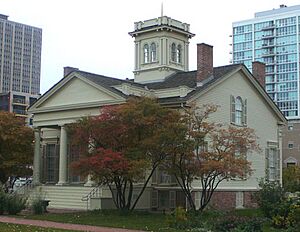Henry B. Clarke House facts for kids
|
Clarke-Ford House
|
|

In March 2022
|
|
| Location | 1827 S. Indiana Ave. Chicago, Illinois, United States |
|---|---|
| Built | circa 1836 |
| Architectural style | Greek Revival |
| NRHP reference No. | 71000290 |
Quick facts for kids Significant dates |
|
| Added to NRHP | 1971 |
The Clarke-Ford House is a very old home in Chicago, Illinois. It was built around 1836 and is thought to be the oldest house still standing in Chicago! This house is built in the Greek Revival style, which was popular a long time ago. Today, it is a house museum where people can visit and learn about its history.
The house was first built for Henry Brown Clarke and his wife, Caroline Palmer Clarke. Henry Clarke moved to Chicago in 1833 and owned a hardware business. He sold building materials to help Chicago grow. The house was built by a local contractor named John C. Rue.
The Clarke-Ford House has been moved twice! It was first built near Michigan Avenue and 17th Street. In 1977, it was moved to its current spot on Indiana Avenue and 18th Street. This new location is close to where it originally stood. In the mid-1900s, a church and its leader, Bishop Louis Henry Ford, and his wife, Margaret, helped take care of the house. They worked hard to save it because it was Chicago's oldest home. Now, the house is in a park with gardens. It is part of the Prairie Avenue Historic District in the Near South Side area of Chicago.
Contents
Chicago's Oldest House
The Clarke-Ford House is known as the oldest house still standing in Chicago. It was made a special "Chicago Landmark" on October 14, 1970. This means it's an important historical place. It was also added to the National Register of Historic Places on May 6, 1971.
When Henry Clarke first built the house, it was on a large piece of land near Michigan Avenue. He was one of the first wealthy people to build a home south of the Chicago River. Henry Clarke faced money problems around 1837. Because of this, he used his land for farming and hunting. This also meant that some rooms in his house were not finished right away.
The Widow Clarke's House
Henry Clarke passed away in 1849. After his death, his wife, Caroline Palmer Clarke, lived in the house until 1860. During this time, people called it the "Widow Clarke's House." To support her family, Caroline sold most of the land that came with the house. She used the money to fix up her home. She added a fancy back porch with columns, similar to the front porch. This new porch faced Michigan Avenue, which had just gotten gas streetlights. She also added a small tower on the roof and decorated the dining room and front living room, which had been unfinished.
In 1871, a tailor named John Chrimes bought the house. He moved it even farther south to 45th Street and Wabash Avenue. This area was then called Hyde Park. When the house was being moved, workers found a hidden packet of papers. It seemed Henry Clarke had buried them when he built the house! The packet contained old tax papers, newspapers, and a note from Henry Clarke himself.
Later, in the 1900s, the house became part of the St. Paul Church of God in Christ. It was used as a home for the pastor and a community hall. Bishop Louis Henry Ford, a leader of the church, lived and worked there. He did a lot to fix and save the house. He also helped the city learn about its important history. The Bishop Ford Freeway was later named after him.
Moving the House Again
In 1977, the City of Chicago bought the house. They decided to move it to its current location. This was a huge project! The entire building had to be lifted over the "L" train tracks on the Englewood-Jackson Park line. It was a very cold night in December, and the equipment used to lift the house froze. The house sat next to the train tracks for two weeks until it could finally be moved to its new home at 1827 S. Indiana Avenue.
Renaming the House
Over time, more people became interested in the history of the house and how it was saved. The St. Paul Church of God in Christ wanted to honor Bishop Louis Henry Ford. Bishop Ford's grandson, Pastor Kevin Anthony Ford, led this effort. On November 18, 2022, the Chicago City Council officially approved renaming the house. It is now called the Henry B. and Caroline Clarke/Bishop Louis Henry and Margaret Ford House. This new name recognizes the important roles of Caroline Clarke, Bishop Louis Henry Ford, and Margaret Ford in preserving this historic home.
Clarke-Ford House Museum
Today, the Clarke-Ford House is a museum. It is managed by the Chicago Department of Cultural Affairs and Special Events. A group called The National Society of The Colonial Dames of America in the State of Illinois helps by providing old furniture and decorations. This makes the house look like it did when the Clarke family lived there.


